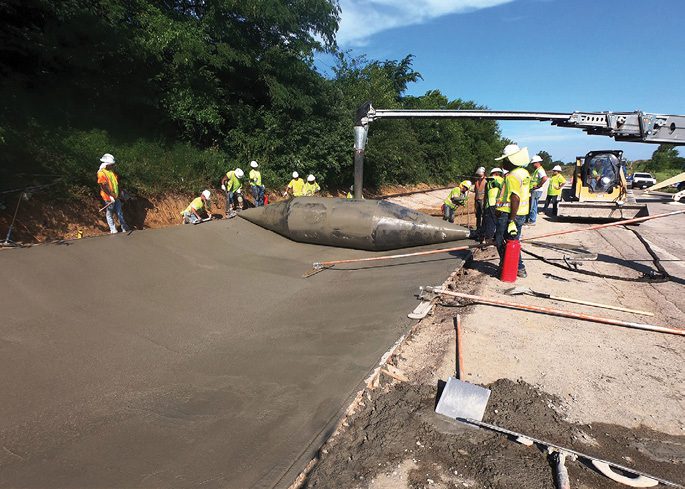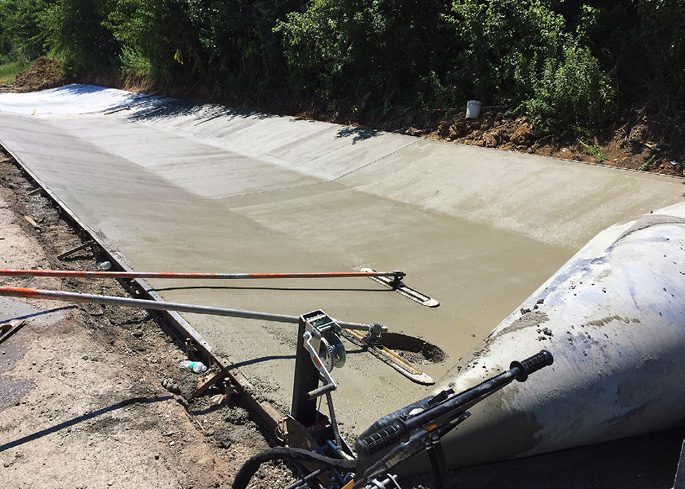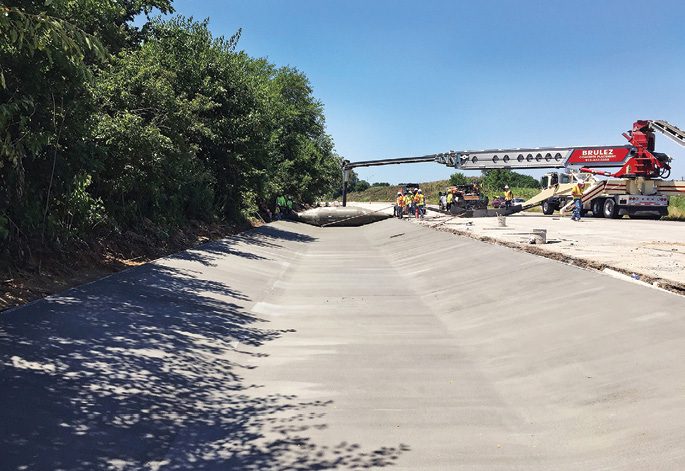Ready to Roll: How 1,000 Pounds of Spinning Metal Overcame Onramp Runoff

To complete a Missouri ditch-liner project, Realm Construction poured 400-450 linear feet of concrete a day and finished the project more than one week ahead of schedule.
Near the Kansas City International Airport lies a well-traveled but problematic onramp that connects NE Cookingham Drive to I-435. A field that runs parallel to the ramp often produces significant rainwater runoff that makes its way onto the onramp. Sedimentary dirt and debris would fill the south side of the ditch as well as the onramp. As the ditch filled, the material would spill over onto the onramp’s south lane, creating slippery, dangerous situations for drivers heading for the interstate at 55-60 mph.
To combat the issue, the Missouri Department of Transportation (MoDOT) maintenance crews used heavy-duty equipment to tackle the buildup, closing the onramp every few years to clear the ditch and roadway with skid steers, track hoes and several haul trucks. This method solved the problem temporarily but created headaches for drivers and a lot of unnecessary work for crews.
MoDOT tried incorporating pre-shaped paved flumes to carry the rainwater, but the flumes filled up just as quickly as the unpaved ditch and required just as much cleaning. MoDOT contemplated installing a rock-based lining, but research showed the quickly accumulating rainwater would likely carry the rocks away.
Finding a Unique Solution
In the early summer of 2019, Realm Construction was subcontracted to patch the concrete on Cookingham Drive and the onramp to I-435. Manager of Field Operations Russ Stark and his team specialize in concrete patchwork. They completed that portion of the job and then sat down to find a way to tackle the ditch liner, which was a concrete project they were less familiar with.
Stark, who has worked for Realm for more than 11 years, needed a solution that would stay within the budget and assigned timeframe. The mission was to line the ditch with concrete, and Stark initially only knew of one conventional method to accomplish it: form the ditch in a sectional approach.
“If we approached this project the conventional way, we’d only be able to pour about 80 feet of ditch liner a day,” notes Stark. “At that rate, the project would have taken 15 to 20 days. I knew we could do it quicker than that.”
Stark proposed commissioning a large metal flume drum from Curb Roller Manufacturing, which is known for its hydraulic- and battery-powered concrete roller screeds but also manufactures custom-sized rolling drums used for pouring streets, medians, v-gutters or flumes. Although the company prides itself on creating custom solutions, this drum exceeded the size of any created in the past.

For the project, Curb Roller Manufacturing created a custom flume drum with eye-catching dimensions: 24 feet wide, 1,000 pounds and 52 inches in diameter. Each wing section of the drum was 8 feet wide, with an 8-foot flat pan section in the middle.

If crews had done the whole project by hand, there would have been an increased potential for neck, knee and back injuries along the way.
“I had seen a ditch liner drum on a different project a year prior and asked the contractor—Clarkson Construction—who made it,” says Stark. “It was only about 14 feet wide, and I knew we’d need something nearly double that size. But I thought it could work.”
When Realm Construction approached Curb Roller Manufacturing with the custom request, it was eager to engineer a solution. The contractors also were ready to begin the project, but delivering an oversized custom drum to a jobsite had its obstacles. First, Stark had to get approval from MoDOT to implement this unique equipment and process. He presented his case, highlighting the potential for a better finished product and a significantly improved timeline.
Matt Daulton, MoDOT resident engineer for the project, reviewed Stark’s proposal and approved it with one stipulation: the project’s overall cost could not increase.
“We try to encourage innovation on every project,” adds Daulton. “I had never seen something like this, but our contractors and manufacturers in the industry often have new ideas and the best answers. So we were open to it.”
After gaining clearance from MoDOT, Stark and his team had to work with the grading and excavation subcontractor preparing the ditch. The original design of the ditch, before implementing the Curb Roller idea, included varying widths and a flat bottom. This approach would save grading and excavating costs on a traditional concrete project, but the Curb Roller method would require a consistent width to successfully lay concrete. Stark was convinced the extra cost in grading and excavating would make up for itself in time savings down the line.
“I knew this would create a more-uniform product, which would be easier for MoDOT maintenance to clean out,” explains Stark. “The original cross section of the ditch had varying slope widths and lengths through the entire 1,600-foot-long ditch liner. So we had to get the grading team to adjust and create a consistent canvas for the concrete.”
While the grading and excavating teams prepared the base, Stark worked with Curb Roller Manufacturing to design and craft the flume drum.

Curb Roller Manufacturing delivered the drum to the jobsite just five days after the design was approved by the contractor.

As a result of using new technologies and techniques on the ditch-liner project, the contractor estimates a cost savings of 40 percent and more than 740 man-power hours saved.
Here Comes the Drum
Curb Roller Manufacturing worked with Stark throughout the planning process. While the company specializes in custom drums, it had never designed something of this magnitude before.
Stark officially submitted his order to Curb Roller Manufacturing: a 24-foot-wide, 1,000-pound hollow rolling flume drum. He calculated the required slope of the sides of the ditch according to MoDOT requirements. Each wing section of the drum was 8 feet wide, with an 8-foot flat pan section in the middle. The drum was 52 inches in diameter with 4:1 backslopes. Since the ditch liner itself is 2 feet deep, they achieved a 25-degree rise by implementing a 1-foot drop for every 4-foot run.
Curb Roller Manufacturing sent Stark a design of the product, which he promptly approved. The company delivered the drum to the jobsite five days later.
Time to Rock and Roll
By the time the drum arrived on the jobsite, the Realm Construction team had prepared the first section of the pour with forms, fabric and reinforcement. Not knowing exactly how quickly the pours would go or how much progress they’d make, the team prepared 500 feet of forms.
Also onsite was a Takeuchi TL10 compact track loader that provided hydraulic power for the spinning drum, as well as a Telebelt telescopic belt conveyor to place the concrete. The team modified the conveyor to lay the concrete in front of the tube. They began pouring the concrete—a MoDOT hand-finished paving mix with a predetermined slump calculation.
“We were allowed to go to 5-inch slump, but we aimed for a 3.5-inch slump because of the slope,” notes Stark. “We had more of a problem getting it too wet, which is OK because we just let it dry out.”
After everything was dialed in and set to the perfect speed, distance and power, the Realm Construction team was on a roll. It poured 400-450 linear feet of concrete a day for the next three days, with virtually no roadblocks or issues, completing the project more than a week ahead of schedule.
Completing the project in essentially three pours, the team saved time and physical labor and created a higher-quality product. With a traditional method and many sections of concrete pours, dowels would have been required in each bay to tie them back to one another. While incorporating dowels creates a sturdy project, it’s certainly not as uniform or smooth as the three-pour approach with the Curb Roller.
“If they’d done this by hand, the quality and consistency goes way down,” notes Daulton. “Since they did it in three large pours, it created a monolithic, uniform product.”
Savings Upon Savings
With a traditional method, the process could have cost roughly $60,000 in labor. On a 15-day project with a 10-man crew costing roughly $400/day per worker, the cost is significant. With the same calculations on the Curb Roller six-day custom drum method, the labor cost equates to roughly $24,000—a 40-percent savings in cost and more than 720 hours of saved manpower.
Although there were additional costs throughout the project—purchasing the custom drum, renting the Telebelt, etc.—Stark says they still ended up under budget on the project.
“Everyone involved came out on top,” explains Stark. “MoDOT got a higher-quality product in less time and with less traffic disruption. We saved time and money on the overall project, making it a more-profitable venture. And Curb Roller had the opportunity to test the limits of their drums.”
Quite the Sight
On a project such as this, it’s no surprise everyone involved was curious about the process. Workers, supervisors and even those driving by were spotted taking photos or video of the impressive setup. All the contractors, manufacturers and MoDOT people involved kept a close eye on the project and were impressed with the equipment throughout.
“This was a real partnership, and we were more than pleased with the end result,” says Daulton. “We’ve worked with Realm Construction in the past, so I trusted their judgment when Russ said he had a new idea. We got a better final product, and they were able to decrease their cost and share some of that with us.”
The MoDOT maintenance team perhaps benefits most from the final product, since it makes their cleanup efforts a much simpler job. The team uses a skid steer to clear the ditch after every significant rainfall, and it doesn’t require any lane closure or traffic disruption.
The project showcased everyone’s ingenuity; it highlighted MoDOT’s judgment, the contractor’s ability to think outside the box, and the manufacturer’s high-quality product. All parties agree, this project was a win-win-win. 


